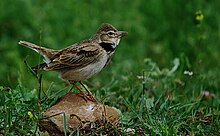Calandra lark
| Calandra lark | |
|---|---|
 |
|
| Scientific classification | |
| Kingdom: | Animalia |
| Phylum: | Chordata |
| Class: | Aves |
| Order: | Passeriformes |
| Family: | Alaudidae |
| Genus: | Melanocorypha |
| Species: | M. calandra |
| Binomial name | |
|
Melanocorypha calandra (Linnaeus, 1766) |
|
| Synonyms | |
|
|
The calandra lark (Melanocorypha calandra) or European calandra-lark breeds in warm temperate countries around the Mediterranean and eastwards through Turkey into northern Iran and southern Russia. It is replaced further east by its relative, the bimaculated lark.
The calandra lark was originally placed in the genus Alauda. The current genus name, Melanocorypha is from Ancient Greek melas, "black", and koruphos a term used by ancient writers for a now unknown bird, but here confused with korudos, "lark". "Calandra"' derives ultimately from kalandros the Ancient Greek name for this bird. The bimaculated lark is also sometimes termed as the calandra lark.
Four subspecies are recognized:
This is a large, robust lark, 17.5–20 cm long. It is an undistinguished-looking species on the ground, mainly streaked greyish brown above and white below, and with large black patches on the breast sides. It has a white supercilium.
In flight it shows short broad wings, which are dark below, and a short white-edged tail. The wing and tail patterns are distinctions from its more easterly relatives.
The song is like a slower version of that of the skylark.
It is mainly resident in the west of its range, but Russian populations of this passerine bird are more migratory, moving further south in winter, as far as the Arabian peninsula and Egypt. It is a very rare vagrant to western Europe.
This is a bird of open cultivation and steppe. Its nest is on the ground, with 4–5 eggs being laid. Food is seeds supplemented with insects in the breeding season. It is gregarious outside the breeding season.
Parasites of the calandra lark include the chewing louse Ricinus vaderi, described from specimens collected in Azerbaijan.
...
Wikipedia

